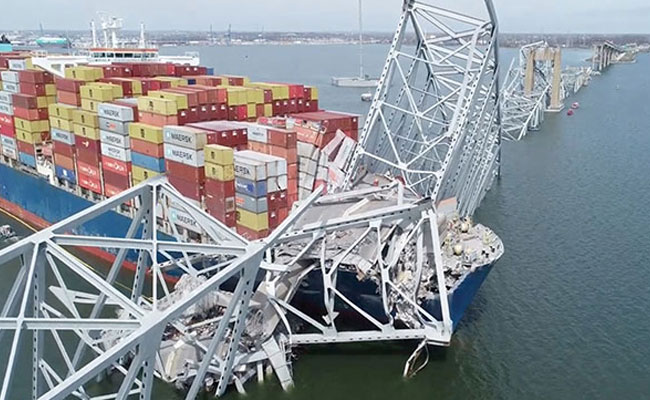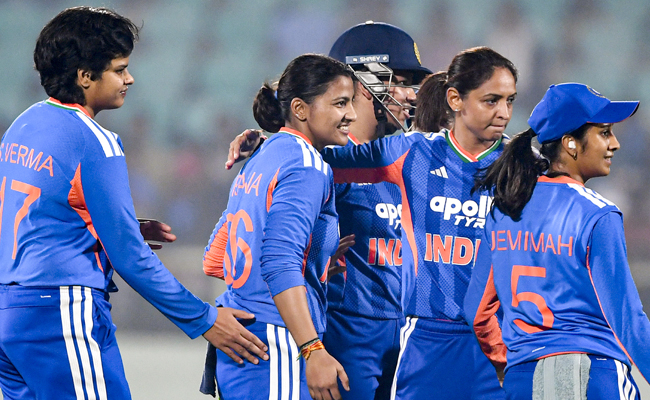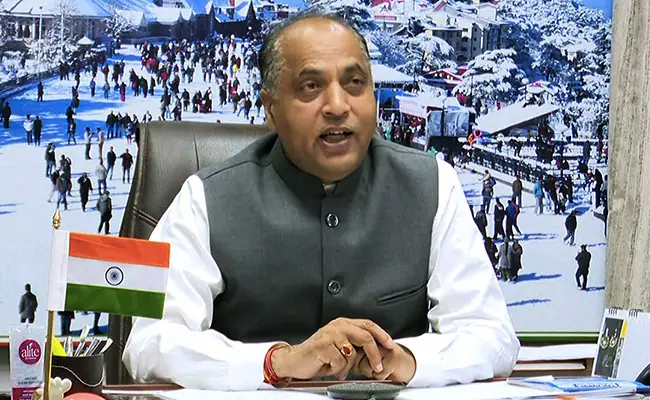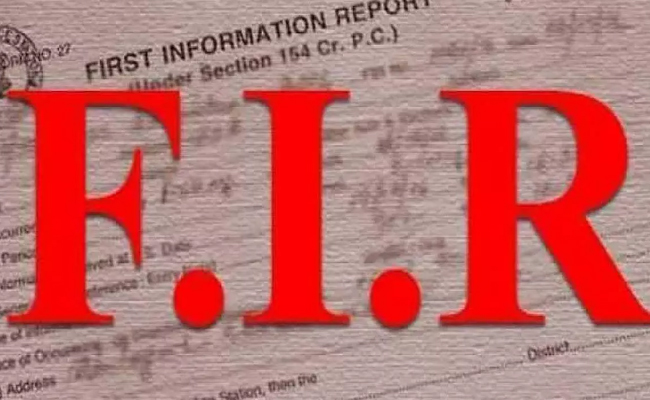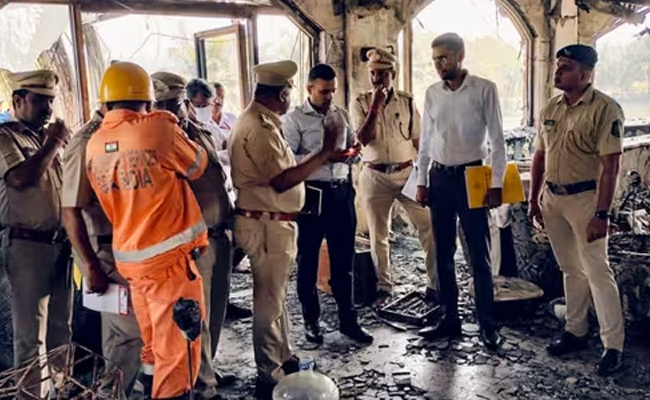Baltimore (AP/PTI): The expert pilots who navigate massive ships in and out of Baltimore's port must often manoeuvre with just two feet of clearance from the channel floor and memorise charts, currents and every other possible maritime variable.
The highly specialised role - in which a pilot temporarily takes control of a ship from its regular captain - is coming under the spotlight this week.
Two pilots were at the helm of the cargo ship Dali about 1.25 am Tuesday when it lost power and, minutes later, crashed into a pillar of the Francis Scott Key Bridge, causing the bridge to collapse and kill six construction workers.
While the incident will undoubtedly raise larger questions about ship and port safety protocols, so far there is no indication the pilots on the Dali did anything wrong given the immediate situation they faced.
The ship sent out a mayday call, which gave just enough time for authorities to close the bridge to traffic and likely prevented further deaths. The lead pilot also dropped an anchor, issued steering commands and called for help from nearby tugboats, according to a preliminary timeline outlined by the National Transportation Safety Board.
But in the end, maritime experts say, there was likely nothing the pilots could have done to stop the 95,000-ton ship from ploughing into the bridge.
"It's completely their worst nightmare," said Capt Allan Post, the deputy superintendent of the Texas A&M Maritime Academy in Galveston. "It is terrifying to even imagine not being able to control the vessel, and knowing what's going to happen, and not being able to do anything about it."
Pilots are local knowledge experts, and they give commands to the bridge team for rudder and engine settings, and for what course to steer, Post said.
US pilots are typically graduates of maritime academies and have spent many years at sea before they join a lengthy apprentice programme to learn every aspect of a local area, including memorising charts, he said.
"A ship's captain is a general practitioner, if I was to use a medical term," Post said. "And a pilot would be a surgeon."
Ship pilots have been working in the Chesapeake Bay since 1640, and the Association of Maryland Pilots currently has 65 active pilots on its books.
The association describes on its website how the bay throws up unique challenges, including that pilots must manoeuvre container ships that can sit nearly 48 feet deep in the water through the main Baltimore shipping channels, which are only 50 feet deep.
"Pilots are on the front lines protecting the environmental and ecological balance of the Chesapeake Bay by ensuring the safe passage of these large ships that carry huge quantities of oil and other hazardous materials," the association says on its site.
The association, which didn't immediately respond to a request for comment, has issued a statement thanking first responders to the bridge accident and saying its members' thoughts and prayers are with the families of victims.
There is lucrative pay for pilots because the job comes with plenty of responsibility and risk, Post said.
On a typical day, he said, a pilot might make multiple trips. He or she would be assigned to one ship leaving a port, Post said, and then disembark to board a second, inbound ship.
He said that of the two pilots assigned to the Dali, one would have been in command, with the second able to assist if necessary. He said that, typically, the ship's regular captain would also have been on the bridge, along with one of the watch officers and a couple of other crew.
The NTSB timeline indicated the pilots had less than five minutes from when they first lost power to when the ship struck the pillar.
"They had very little time from the start of the incident until the time they were upon the bridge," Post said. "I believe the pilots did what they could with the abilities that they had onboard the ship at the time to avoid the collision."
Let the Truth be known. If you read VB and like VB, please be a VB Supporter and Help us deliver the Truth to one and all.
Visakhapatnam (PTI): Shafali Verma hit a blistering unbeaten 69 as India made short work of a paltry target to outclass Sri Lanka by seven wickets in the second Women’s T20 International here on Tuesday.
India now lead the five-match series 2-0 after another one-sided victory, having restricted Sri Lanka to a modest 128 for 9 through a collective display of disciplined bowling from the spin trio of seasoned Sneh Rana, ably complemented by young spinners Vaishnavi Sharma and Shree Charani.
During the chase, vice-captain Smriti Mandhana (14) fell cheaply but Shafali, enjoying new found confidence after a stellar show in the World Cup final, sent the bowlers on a leather-hunt during her 34-ball knock, winning it for her team in just 11.5 overs.
The hosts have now completed back-to-back successful chases within 15 overs which speaks volumes about the unit's sky-high confidence.
Shafali's innings had 11 punchy boundaries apart from a maximum.
The floodgates opened when left-arm spinner Inoka Ranaweera bowled a few flighted deliveries and Shafali would step out everytime to hit her over extra cover. Her footwork against slow bowlers was immaculate whether stepping out to loft the ball or rocking back to punch or pull.
Seeing her confidence, the newly appointed Delhi Capitals skipper Jemimah Rodrigues (26 off 15 balls) also attacked as the duo added 58 runs in just 4.3 overs.
By the time Rodrigues was out trying to hit one six too many, the match as a contest was over. Shafali completed her half-century off just 27 balls and completed the formalities in a jiffy.
Earlier, off-spinner Rana, who got a look-in after Deepti Sharma was ruled out due to fever, showed her utility keeping the Lankan batters under tight leash with figures of 1 for 11 in 4 overs, including a maiden which certainly is a rarity in T20 cricket.
Charani, who made an impression during India's ODI World Cup triumph, took 2 for 23 in her quota of overs, while Vaishnavi after an impressive debut in the opening encounter, finished with 2 for 32, not letting the Islanders get easy runs in her second spell.
The last six wickets fell for just 24 runs, but what stood out during India’s bowling effort was their superb ground fielding. After a patchy show in the previous game, the improved sharpness in the field resulted in three run-outs.
Sri Lankan skipper Chamari Athapaththu (31 off 24 balls) looked in good nick as she deposited length deliveries from seamers Kranti Gaud and Arundhati Reddy over the ropes but it was Rana, who kept her quiet by repeatedly pitching on good length.
Unable to manoeuvre the strike and with the big hits suddenly drying up, Athapaththu chanced her arm at another delivery in which Rana had shortened the length slightly.
Not having transferred the weight into the lofted shot, Athapaththu's hoick was pouched cleanly by Amanjot Kaur at long-off.
This was after Athapaththu's opening partner Vishmi Gunaratne (1) had offered a simple return catch to Gaud.
Hasini Perera (22 off 28 balls) and Harshitha Samarawickrama (33 off 32 balls) did stitch a stand of 44 but they could never set the tempo against the Indian spin troika.
Once Hasini offered a tame return catch off a Charani full-toss, Sri Lankans never recovered and lost wickets in a heap towards the end.

